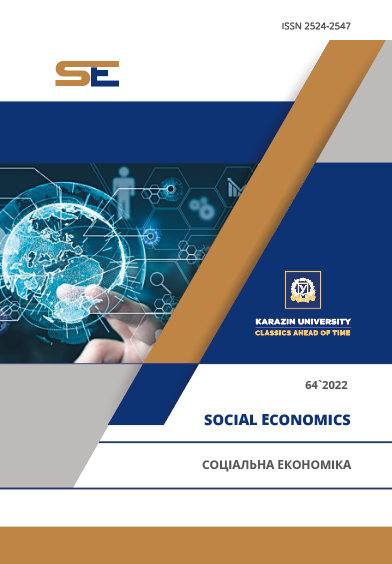INTRODUCTION OF ARTIFICIAL INTELLIGENCE ACHIEVEMENTS – A PREREQUISITE FOR LABOR MARKET TRANSFORMATION
Abstract
The article presents the theoretical and methodological foundations of artificial intelligence. It is noted that artificial intelligence solves the main problem of health care successfully - overload and shortage of personnel. The reasons for the rapid development of robotization processes in industrialized countries in many branches and spheres of production and the ability of robots to replace workers and office workers and threaten people with job loss are investigated. Attention is focused on need for self-education and retraining of workers, and their ability to work in the conditions of the fourth industrial revolution, and of course, obstacles that stand in the way of the implementation of artificial intelligence achievements. Catastrophic lagging of Ukraine in the field of robotics from the industrialized countries of the world, and the need for a significant acceleration of robotics processes in the main branches of production and in the service sector are emphasized. The transformation of artificial intelligence into a universal resource is accelerated due to the emergence of new tools that make this technology accessible to a wide range of people, and to those who do not have a special education. It is evident that robots will not be able to apply for professions that require creativity, empathy, and communication skills. However, artificial intelligence threatens the middle class, specialists, employees, and office workers. In order not to lose their jobs, many people will need to retrain on online educational platforms, where any person who is sufficiently proactive and capable of mathematics can acquire basic knowledge through educational portals and software tools, which will make deep learning more accessible. Therefore, there is a chance to have a well-paid job and start a fruitful career, taking into account the requirements of the market. The implementation of artificial intelligence achievements opens up great opportunities for the introduction a whole series of tasks facing society in many spheres of people’s lives.
Downloads
References
Smirnova, I., & Levchenko, K. (2020). Inhuman efforts. Arguments and facts in Ukraine, 52, 8. (in Ukrainian)
Azimov, A. (2021). People on Earth must live. Results of the week, 52, 24. (in Ukrainian)
Kozhemyakin, V. (2021). Who will be replaced by robots. Arguments and facts in Ukraine, 17, 4. (in Ukrainian)
Wanda, I., & Negoda, L. (2021). To whom and the robot worker. Arguments and facts in Ukraine, 17, 23. (in Ukrainian)
Filchenkov, A. (2021). Robotic people. Arguments and facts in Ukraine, 3, 5. (in Ukrainian)
Oliynik, S. (2017). Threatening people with unemployment. Express, 43, 10. (in Ukrainian)
Azmuk, N. (2019). Artificial intelligence on the labor process in the digital economy: new challenges and opportunities. Economic Herald of the Donbass, 3 (57), 137-145. doi: https://doi.org/10.12958/1817-3772-2019-3(57)-137-145 (in Ukrainian)
Kraus, K., Kraus, N., & Holubka, S. (2022). Establishment of work 4.0 in the conditions of digitalization and the application of artificial intelligence. European Scientific Journal of Economic and Financial Innovation, 2(10), 19-31. doi: https://doi.org/10.32750/2022-0202 (in Ukrainian)
Hrazhevska, N., & Rozum, D. (2019). Transformation of labor market under the influence of the artificial intelligence. Odesa National University Herald. Series Economy, 24, 5(78), 137-145. doi: https://doi.org/10.32782/2304-0920/5-78-1 (in Ukrainian)
Damioli, G., Van Roy, V., & Vertesy, D. (2021). The impact of artificial intelligence on labor productivity. Eurasian Bus Rev, 11, 1–25. doi: https://doi.org/10.1007/s40821-020-00172-8
Johnson, M., Jain, R., Brennan-Tonetta, P. et al. (2021). Impact of Big Data and Artificial Intelligence on Industry: Developing a Workforce Roadmap for a Data Driven Economy. Glob J Flex Syst Manag, 22, 197–217. doi: https://doi.org/10.1007/s40171-021-00272-y
Wagner, D. N. (2020). Economic patterns in a world with artificial intelligence. Evolut Inst Econ Rev, 17, 111–131. doi: https://doi.org/10.1007/s40844-019-00157-x
Fanti, L., Guarascio, D., & Moggi, M. (2022). From Heron of Alexandria to Amazon’s Alexa: a stylized history of AI and its impact on business models, organization and work. J. Ind. Bus. Econ., 49, 409–440. doi: https://doi.org/10.1007/s40812-022-00222-4
Bertani, F., Raberto, M., & Teglio, A. (2020). The productivity and unemployment effects of the digital transformation: an empirical and modelling assessment. Rev Evol Polit Econ, 1, 329–355. doi: https://doi.org/10.1007/s43253-020-00022-3
Braña, FJ. (2019). A fourth industrial revolution? Digital transformation, labor and work organization: a view from Spain. J. Ind. Bus. Econ., 46, 415–430. doi: https://doi.org/10.1007/s40812-019-00122-0
Degtyareva, E. (2017). When will the uprising of machines begin? Results of the week, 18, 26. (in Ukrainian)
Vannakh,M. (2018). How robots quarrel politicians. Results of the week, 31, 26. (in Ukrainian)
Nekrasov, V. (2019). USA against China: who will win the war for technology and what is at stake. Ekonomichna pravda. Retrieved from https://www.epravda.com.ua/publications/2019/09/4/651246/. (in Ukrainian)
Antropov, I. (2019). When will the flying car appear? Arguments and facts in Ukraine, 28, 21. (in Ukrainian)
Medun, Y. (2011). High technologies that will turn the world upside down. 2000, 42, 27. (in Ukrainian)
Kasatonov, V. (2021). Covid enriched Silicon Valley. Results of the week, 6, 9. (in Ukrainian)
Vasiliev N. (2021).Why young people don`t want to work. Arguments and facts in Ukraine, 36, 9. (in Ukrainian)




